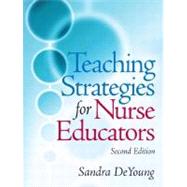
| Preface | p. xi |
| Acknowledgments | p. xiii |
| Contributing Authors | p. xiii |
| Reviewers | p. xiii |
| Teaching and Learning | p. 1 |
| Good Teaching | p. 3 |
| Hallmarks of Good Teaching | p. 3 |
| Teacher Style | p. 8 |
| Seven Principles of Good Practice in Undergraduate Education | p. 9 |
| Nurses as Teachers | p. 10 |
| References | p. 12 |
| Learning Theory | p. 14 |
| Learning Theories | p. 14 |
| Types of Learning | p. 26 |
| Learning Styles | p. 30 |
| References | p. 36 |
| Motivation and Behavior Change | p. 39 |
| Learner Characteristics | p. 39 |
| Planning for Learning | p. 41 |
| Motivation and Behavior Change Theories | p. 44 |
| Summary | p. 53 |
| References | p. 54 |
| Literacy | p. 56 |
| Literacy Levels | p. 56 |
| Reading Levels | p. 56 |
| The Importance of Adequate Literacy | p. 58 |
| Assessing Literacy | p. 59 |
| Teaching People with Low-Literacy Skills | p. 60 |
| Developing Printed Educational Materials | p. 61 |
| Information Literacy | p. 65 |
| References | p. 68 |
| Multicultural Aspects of Learning | p. 70 |
| Learning About Culture | p. 70 |
| The Culture of Teachers and Learners | p. 73 |
| Teaching Strategies | p. 77 |
| Communication Issues | p. 80 |
| References | p. 86 |
| Planning and Conducting Classes | p. 89 |
| The Planning Sequence | p. 89 |
| Selecting Teaching Methods | p. 96 |
| Choosing a Textbook | p. 98 |
| Planning Assignments | p. 103 |
| Conducting the Class | p. 105 |
| References | p. 108 |
| Teaching Strategies | p. 109 |
| Traditional Teaching Strategies | p. 111 |
| Lecturing | p. 111 |
| Discussion | p. 120 |
| Questioning | p. 123 |
| Using Audiovisuals | p. 129 |
| The Interactive Lecture | p. 134 |
| References | p. 135 |
| Activity-Based Teaching Strategies | p. 138 |
| Cooperative Learning | p. 138 |
| Simulations | p. 141 |
| Problem-Based Learning | p. 151 |
| Self-Learning Modules | p. 155 |
| References | p. 162 |
| Computer Teaching Strategies | p. 168 |
| Computer Technology and Learning | p. 168 |
| Computer-Assisted Instruction | p. 170 |
| Computer-Managed Instruction | p. 176 |
| The Internet | p. 178 |
| Virtual Reality | p. 181 |
| References | p. 183 |
| Distance Learning | p. 186 |
| Advantages and Disadvantages of Distance Learning | p. 186 |
| Clinical Education in Distance Learning | p. 187 |
| Interactive Television Classes | p. 187 |
| Distance Learning via the Internet | p. 191 |
| References | p. 198 |
| Teaching Psychomotor Skills | p. 201 |
| History of Teaching Psychomotor Skills | p. 201 |
| Learning Psychomotor Skills | p. 203 |
| Approaches to Teaching Skills | p. 209 |
| Assessment of Psychomotor Skill Learning | p. 212 |
| Which Skills Should be Taught? | p. 212 |
| References | p. 214 |
| Promoting and Assessing Critical Thinking | p. 217 |
| Defining Critical Thinking | p. 218 |
| Distinguishing Critical Thinking from Other Concepts | p. 222 |
| Ways We May Inhibit the Critical Thinking of Nursing Students | p. 223 |
| Strategies that Enhance Critical Thinking | p. 224 |
| Assessing Critical Thinking | p. 231 |
| Conclusion | p. 233 |
| References | p. 235 |
| Clinical Teaching | p. 239 |
| Purpose of the Clinical Laboratory | p. 239 |
| Models of Clinical Teaching | p. 241 |
| Preparation for Clinical Instruction | p. 245 |
| Conducting a Clinical Laboratory Session | p. 246 |
| Evaluating Learner Progress | p. 253 |
| Clinical Evaluation Tools | p. 257 |
| References | p. 259 |
| Assessing and Evaluating Learning | p. 263 |
| Classroom Assessment | p. 263 |
| Evaluation of Learning | p. 267 |
| Test Item Analysis | p. 277 |
| References | p. 280 |
| The Professional Teacher | p. 283 |
| The Faculty Role | p. 285 |
| Finding the Right Educational Setting | p. 285 |
| The Appointment Process | p. 285 |
| Reappointment, Tenure, and Promotion | p. 287 |
| Teaching Assignments and Academic Freedom | p. 289 |
| Curriculum Development | p. 290 |
| Student Advisement | p. 290 |
| Program Assessment | p. 291 |
| Committee Work | p. 291 |
| Table of Contents provided by Publisher. All Rights Reserved. |
The New copy of this book will include any supplemental materials advertised. Please check the title of the book to determine if it should include any access cards, study guides, lab manuals, CDs, etc.
The Used, Rental and eBook copies of this book are not guaranteed to include any supplemental materials. Typically, only the book itself is included. This is true even if the title states it includes any access cards, study guides, lab manuals, CDs, etc.